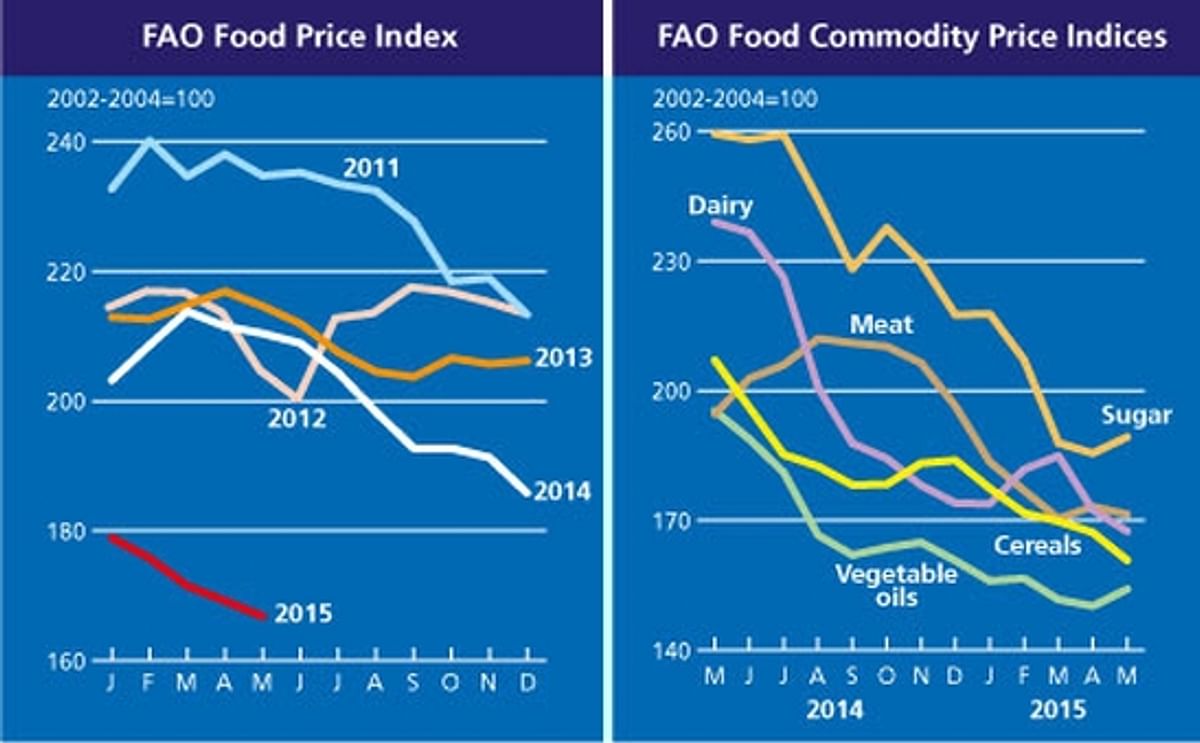The FAO Food Price Index averaged 166.8 points in May 2015, down 2.4 points (1.4 percent) from April and as much as 43.6 points (20.7 percent) below the corresponding month last year. Cereals and dairy products were responsible for much of last month’s decline, although meat quotations also fell. By contrast, oils and sugar markets firmed. The May average puts the FAO Food Price Index at its lowest level since September 2009.
The FAO Cereal Price Index averaged 160.8 points in May, 6.4 points (3.8 percent) less than in April and 46 points (22.4 percent) below its level in May 2014. Ample stocks combined with generally favourable crop outlooks for this year continued to keep international prices under downward pressure. Subdued trade prospects, with many importing countries postponing purchases to later this year, also contributed to the general decline in prices. The May average was the lowest since July 2010.
The FAO Vegetable Oil Price Index averaged 154.1 points in May, up 3.9 points (or 2.6 percent) from April, although still 41 points (21 percent) below the corresponding month last year. The gain has been driven by rising quotations for both palm and soy oils. Palm oil prices strengthened mainly on account of increased concerns about possible El Niño developments which could affect production in Southeast Asia, while soy oil values firmed primarily on resumed import demand – by China in particular. Quotations for sunflower and rapeseed oil also moved up, reflecting lower than anticipated world production and export supplies.
The FAO Dairy Price Index averaged 167.5 points in May, down 5 points (2.9 percent) from April. Milk powders and butter were the main commodities affected, while cheese remained stable. The lingering low prices characterizing world markets reflects large unsold stocks in New Zealand and the buildup of export supplies in Europe, as production in the northern-hemisphere reaches its seasonal peak. Uncertainty over the level of China's purchases of milk powder during 2015 continues to weigh on the market, although lower prices have stimulated buyer interest in the Middle East and North Africa.
The FAO Meat Price Index averaged 171 points in May, down 1.7 points (1.0 percent) from its revised April value. Generally lower prices for meat exports from the United States continue to weigh on the Index. Overall, international prices of bovine and ovine meat moved lower, while those of poultry and pigmeat were little changed. In the case of poultry meat, import restrictions imposed by some countries due to outbreaks of highly infectious avian influenza in some states in the US also influenced prices. After declining since June 2014, pigmeat meat prices were relatively stable in April and May, with European prices in particular stabilizing.
The FAO Sugar Price Index averaged 189.3 points in May, up 3.7 points (2.0 percent) from April 2015. The increase in May, which represents the first significant rebound since last October, was mainly due to a slow start of the crushing season in Centre/South Brazil, as raw sugar prices remain under the pressure of large supplies and growing surpluses in 2014/15.
FAO Food Price Index falls to its lowest value since September 2009

Like to receive news like this by email? Join and Subscribe!
Get the latest potato industry news straight to your WhatsApp. Join the PotatoPro WhatsApp Community!
Sponsored Content
Sponsored Content
Sponsored Content
Sponsored Content









